- Featured 5
- Photos 3
- Timothy Ide 5
- Jacob Ide 5
- Elmore Ide 12
- Cynthia Ide 2
- Horace Ide 10
- William Ide 5
- Richard Ide 8
- Tim Ide 4
- Rob Ide 2
- Maitland Bean 2
- George Gray 2
- Passumpsic 12
- St. Johnsbury 11
Featured
Millers For A Century
A long newspaper article from The Caledonian published on the occasion of the 100th anniversary in 1913
The close of a century’s ownership finds Elmore T. Ide 74 years old but still at his desk giving the business the benefit of his long and successful experience.
Millers For Five Generations
A booklet published in 1953 on the occasion of the company's 140th anniversary, it presents an idealized version of the business through the first five generations of leadership.
This mill, built about 1789, was the first of several mills that have carried on a tradition of grain and milling for the Ide family through five generations and the trials and triumphs of 140 years of business.
Recollections
William Adams Ide's Recollections were compiled and published in 1951 as a booklet by his great nephew Donald Powell. They provide a tremendous insight into the history and the people behind the business.
I will write down some memories in a rambling manner that may be of interest and amusement in future days.
To Father and Mother from Their Girls
A 50th anniversary gift from the daughters of Elmore and Cynthia Ide, Katherine, Mary Ellen and Fanny. Written by Katherine, lettered by Mary Ellen, and illustrated by Fanny Ide. Katherine married George Gray, Fanny married Oliver Sprague, and Mary Ellen lived at home.
Jacob married Ladoska Knights who was called the prettiest girl in Waterford.
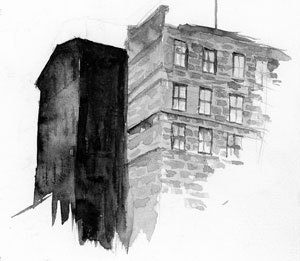
Vermont's Oldest Family Business
A wonderfully written and lavishly illustrated booklet celebrating the 175th anniversary of the business. The oldest family owned and operated feed business in the United States, serving the Upper Connecticut Valley for six generations.
The mill stones were made from local granite. In accordance with an age old custom, the miller was paid in part with a percentage (toll) of the grain he milled. Timothy Ide's toll was a sixteenth part, or two quarts of every bushel he milled.

Photos
Elmore and Cynthia Ide Family Portrait
A family portrait of Elmore and Cynthia Ide circa 1895.
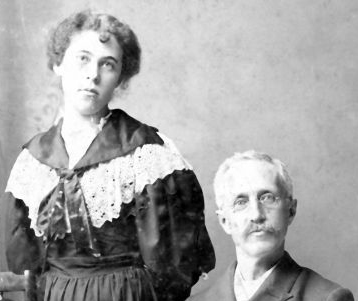
Randall Armor Photographs
A series of photographs of the St. Johnsbury mill taken by Randall Armor on New Year's Eve 2010.
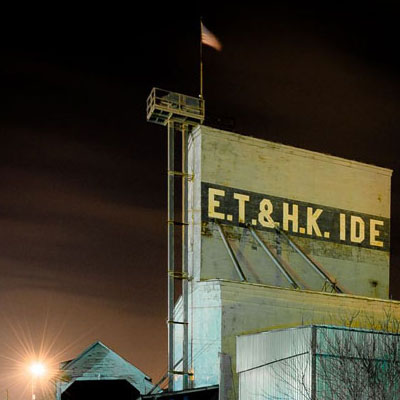
Richard Ide World War II Photos
A collection of snapshots taken by Richard Ide during World War II service. Most and maybe all these photos were taken in Bremen.
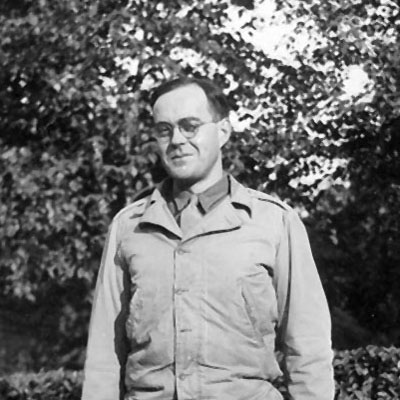
Timothy Ide
Millers For A Century
A long newspaper article from The Caledonian published on the occasion of the 100th anniversary in 1913
The close of a century’s ownership finds Elmore T. Ide 74 years old but still at his desk giving the business the benefit of his long and successful experience.
Millers For Five Generations
A booklet published in 1953 on the occasion of the company's 140th anniversary, it presents an idealized version of the business through the first five generations of leadership.
This mill, built about 1789, was the first of several mills that have carried on a tradition of grain and milling for the Ide family through five generations and the trials and triumphs of 140 years of business.
Recollections
William Adams Ide's Recollections were compiled and published in 1951 as a booklet by his great nephew Donald Powell. They provide a tremendous insight into the history and the people behind the business.
I will write down some memories in a rambling manner that may be of interest and amusement in future days.
A Vermont Milling Dynasty
An article from the September 1958 issue of Eastern Feed Merchant.
Determination and resourcefulness best describe the Ide philosophy for building and maintaining a good business. Going was not always easy.

Vermont's Oldest Family Business
A wonderfully written and lavishly illustrated booklet celebrating the 175th anniversary of the business. The oldest family owned and operated feed business in the United States, serving the Upper Connecticut Valley for six generations.
The mill stones were made from local granite. In accordance with an age old custom, the miller was paid in part with a percentage (toll) of the grain he milled. Timothy Ide's toll was a sixteenth part, or two quarts of every bushel he milled.

Jacob Ide
Millers For A Century
A long newspaper article from The Caledonian published on the occasion of the 100th anniversary in 1913
The close of a century’s ownership finds Elmore T. Ide 74 years old but still at his desk giving the business the benefit of his long and successful experience.
Millers For Five Generations
A booklet published in 1953 on the occasion of the company's 140th anniversary, it presents an idealized version of the business through the first five generations of leadership.
This mill, built about 1789, was the first of several mills that have carried on a tradition of grain and milling for the Ide family through five generations and the trials and triumphs of 140 years of business.
Recollections
William Adams Ide's Recollections were compiled and published in 1951 as a booklet by his great nephew Donald Powell. They provide a tremendous insight into the history and the people behind the business.
I will write down some memories in a rambling manner that may be of interest and amusement in future days.
A Vermont Milling Dynasty
An article from the September 1958 issue of Eastern Feed Merchant.
Determination and resourcefulness best describe the Ide philosophy for building and maintaining a good business. Going was not always easy.

Vermont's Oldest Family Business
A wonderfully written and lavishly illustrated booklet celebrating the 175th anniversary of the business. The oldest family owned and operated feed business in the United States, serving the Upper Connecticut Valley for six generations.
The mill stones were made from local granite. In accordance with an age old custom, the miller was paid in part with a percentage (toll) of the grain he milled. Timothy Ide's toll was a sixteenth part, or two quarts of every bushel he milled.

Elmore Ide
Disastrous Fire at Passumpsic
The St. Johnsbury Caledonian's account of the 1883 fire that destroyed the original Passumpsic mill.
Jacob Ide, the father of the owners of the mill, and the owner before them, was present at the fire and worked hard at saving the property. He came to Passumpsic seventy years ago, and his father before him was the miller at this same mill.
Elmore and Cynthia Ide Family Portrait
A family portrait of Elmore and Cynthia Ide circa 1895.

E. T. Ide in Indiana
A letter from E. T. to American Miller in Feb. 1914 describing the time he spent learning the milling trade in Indiana in 1865.
In 1865 I worked some weeks as millwright, remodeling this mill.
Lighting the Village
This post describes the electrification of St. Johnsbury streets in 1889, and a proposal by E. T. & H. K. Ide to install and power the lights from the water power in Passumpsic.
The Ides have owned a valuable water power at Passumpsic for the last 75 years or more. The present firm have owned it for 22 years.
Millers For A Century
A long newspaper article from The Caledonian published on the occasion of the 100th anniversary in 1913
The close of a century’s ownership finds Elmore T. Ide 74 years old but still at his desk giving the business the benefit of his long and successful experience.
Millers For Five Generations
A booklet published in 1953 on the occasion of the company's 140th anniversary, it presents an idealized version of the business through the first five generations of leadership.
This mill, built about 1789, was the first of several mills that have carried on a tradition of grain and milling for the Ide family through five generations and the trials and triumphs of 140 years of business.
My Grandfather
The author of this biographical sketch of E. T. Ide, possibly a school project, is unknown but it may be Katherine Ide Sprague. Katherine was the daughter of Fanny Knights and Oliver Mitchell Wentworth Sprague. She was born in Tokyo, Japan, and lived in Cambridge, Massachusetts as a girl.
Recollections
William Adams Ide's Recollections were compiled and published in 1951 as a booklet by his great nephew Donald Powell. They provide a tremendous insight into the history and the people behind the business.
I will write down some memories in a rambling manner that may be of interest and amusement in future days.
The Wharf
Article about the development of Bay Street in St. Johnsbury.
A few years ago it was an eyesore, a swamp, an outlet for a number of sewers, a dumping place for rubbish and a dwelling place for bull-frogs.
To Father and Mother from Their Girls
A 50th anniversary gift from the daughters of Elmore and Cynthia Ide, Katherine, Mary Ellen and Fanny. Written by Katherine, lettered by Mary Ellen, and illustrated by Fanny Ide. Katherine married George Gray, Fanny married Oliver Sprague, and Mary Ellen lived at home.
Jacob married Ladoska Knights who was called the prettiest girl in Waterford.

A Vermont Milling Dynasty
An article from the September 1958 issue of Eastern Feed Merchant.
Determination and resourcefulness best describe the Ide philosophy for building and maintaining a good business. Going was not always easy.

Vermont's Oldest Family Business
A wonderfully written and lavishly illustrated booklet celebrating the 175th anniversary of the business. The oldest family owned and operated feed business in the United States, serving the Upper Connecticut Valley for six generations.
The mill stones were made from local granite. In accordance with an age old custom, the miller was paid in part with a percentage (toll) of the grain he milled. Timothy Ide's toll was a sixteenth part, or two quarts of every bushel he milled.

Cynthia Ide
Elmore and Cynthia Ide Family Portrait
A family portrait of Elmore and Cynthia Ide circa 1895.

To Father and Mother from Their Girls
A 50th anniversary gift from the daughters of Elmore and Cynthia Ide, Katherine, Mary Ellen and Fanny. Written by Katherine, lettered by Mary Ellen, and illustrated by Fanny Ide. Katherine married George Gray, Fanny married Oliver Sprague, and Mary Ellen lived at home.
Jacob married Ladoska Knights who was called the prettiest girl in Waterford.

Horace Ide
In Memory Of Companion Horace Knight Ide
A memorial to H. K. Ide published by the Military Order of the Loyal Legion of the United States in 1897.
He was nearly four years in the service, was twice wounded, was twice a prisoner of war, and participated&mdash,it is believed&mdash,in forty-two battles and skirmishes.
Millers For A Century
A long newspaper article from The Caledonian published on the occasion of the 100th anniversary in 1913
The close of a century’s ownership finds Elmore T. Ide 74 years old but still at his desk giving the business the benefit of his long and successful experience.
Recollections
William Adams Ide's Recollections were compiled and published in 1951 as a booklet by his great nephew Donald Powell. They provide a tremendous insight into the history and the people behind the business.
I will write down some memories in a rambling manner that may be of interest and amusement in future days.
A Vermont Milling Dynasty
An article from the September 1958 issue of Eastern Feed Merchant.
Determination and resourcefulness best describe the Ide philosophy for building and maintaining a good business. Going was not always easy.

Vermont's Oldest Family Business
A wonderfully written and lavishly illustrated booklet celebrating the 175th anniversary of the business. The oldest family owned and operated feed business in the United States, serving the Upper Connecticut Valley for six generations.
The mill stones were made from local granite. In accordance with an age old custom, the miller was paid in part with a percentage (toll) of the grain he milled. Timothy Ide's toll was a sixteenth part, or two quarts of every bushel he milled.

Letters From Florida
A collection of letters written by Horace Ide to the editor of the Caledonian giving colorful descriptions of his trips to Florida.
The woman had on an old, dirty calico dress, open in front; shoes, but no stockings, smoked a pipe, and could beat any Yankee expectorating at a mark. They had a little horse and cart, and a few kettles, etc. Something like the following conversation ensued...
From New York To Savannah
Horace describes the rail journey from New York to Savannah and reminisces about his Civil War service. Published January 21, 1876.
We arrived at Salisbury about dark, and I tried to get something to eat from an old lady who had a table on the platform of the depot. She had boiled eggs, bread and fried squirrel, and offered to put me up a snack for one for 25 cents, or a snack for two for 50 cents.
Savannah to Jacksonville
The journey from Savannah to Jacksonville over land and then further south by paddlewheeler on the St. Johns River. Published February 4, 1876.
Arriving at Jacksonville about ten o'clock, P.M., we stopped at the St. John's House, kept by Mrs. Hudnall. Over the door of the dining-room was the motto, "The Lord will Provide" and we judged by the appearance of the table, that it was left almost entirely to him.
A Trip to Dunn's Lake
A visit to Dunn's Lake and an orange grove, and an exounter with a Florida Cracker. Published February 18, 1876.
His apparatus was rather primitive, consisting of two iron rollers set in a wooden frame, and turned by a horse and mule attached to a sweep. The cane was crushed between these rollers, and the juice was caught in a barrel underneath. he gave us some of it to drink, and we found it much sweeter than sap.
Touring Hier's Groves
A trip to a Georgetown orange grove and an encounter with a wild hog. Published February 25, 1876.
The hogs are lean, long-nosed, land-sharks; have a great faculty for finding a hole in a fence, and three of them will destroy an acre of sweet potatoes in one night. I found one in my field one day, and we made up our minds that that hog would not come in there any more. First we stopped up all the holes, and then armed with clubs entered the field intending to kill him.
William Ide
Millers For A Century
A long newspaper article from The Caledonian published on the occasion of the 100th anniversary in 1913
The close of a century’s ownership finds Elmore T. Ide 74 years old but still at his desk giving the business the benefit of his long and successful experience.
Millers For Five Generations
A booklet published in 1953 on the occasion of the company's 140th anniversary, it presents an idealized version of the business through the first five generations of leadership.
This mill, built about 1789, was the first of several mills that have carried on a tradition of grain and milling for the Ide family through five generations and the trials and triumphs of 140 years of business.
Recollections
William Adams Ide's Recollections were compiled and published in 1951 as a booklet by his great nephew Donald Powell. They provide a tremendous insight into the history and the people behind the business.
I will write down some memories in a rambling manner that may be of interest and amusement in future days.
A Vermont Milling Dynasty
An article from the September 1958 issue of Eastern Feed Merchant.
Determination and resourcefulness best describe the Ide philosophy for building and maintaining a good business. Going was not always easy.

Vermont's Oldest Family Business
A wonderfully written and lavishly illustrated booklet celebrating the 175th anniversary of the business. The oldest family owned and operated feed business in the United States, serving the Upper Connecticut Valley for six generations.
The mill stones were made from local granite. In accordance with an age old custom, the miller was paid in part with a percentage (toll) of the grain he milled. Timothy Ide's toll was a sixteenth part, or two quarts of every bushel he milled.

Richard Ide
Ide Company Marks 150 Years Here
An article from the Caledonian-Record on December 21, 1963 on the occasion of the 150th anniversary of E. T. & H. K. Ide. This edition is not available online, fortunately I have five yellowed copies to choose from.
A century and a half, four buildings an six generations have contributed to the success of E. T. & H. K. Ide, Inc.
A 1963 Burlington Free Press article on the occasion of the 150th anniversary of the company.
This is the record which surpasses all other companies under same-family management in Vermont, and perhaps in the country.
Millers For Five Generations
A booklet published in 1953 on the occasion of the company's 140th anniversary, it presents an idealized version of the business through the first five generations of leadership.
This mill, built about 1789, was the first of several mills that have carried on a tradition of grain and milling for the Ide family through five generations and the trials and triumphs of 140 years of business.
Recollections
William Adams Ide's Recollections were compiled and published in 1951 as a booklet by his great nephew Donald Powell. They provide a tremendous insight into the history and the people behind the business.
I will write down some memories in a rambling manner that may be of interest and amusement in future days.
Richard Ide World War II Photos
A collection of snapshots taken by Richard Ide during World War II service. Most and maybe all these photos were taken in Bremen.

Vermont Life Winter 1977
An article from the Winter 1977 edition of Vermont Life magazine.
The whole structure is rather like a giant, compartmentalized hour glass, in which the constant flow of grain measures the passage of the working day.
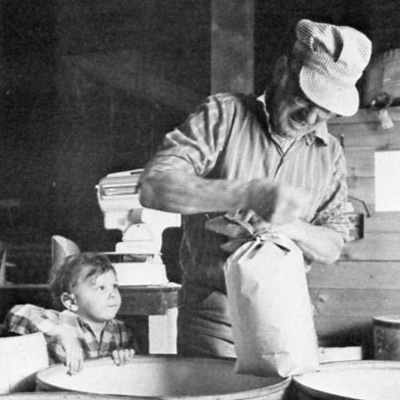
A Vermont Milling Dynasty
An article from the September 1958 issue of Eastern Feed Merchant.
Determination and resourcefulness best describe the Ide philosophy for building and maintaining a good business. Going was not always easy.

Vermont's Oldest Family Business
A wonderfully written and lavishly illustrated booklet celebrating the 175th anniversary of the business. The oldest family owned and operated feed business in the United States, serving the Upper Connecticut Valley for six generations.
The mill stones were made from local granite. In accordance with an age old custom, the miller was paid in part with a percentage (toll) of the grain he milled. Timothy Ide's toll was a sixteenth part, or two quarts of every bushel he milled.

Tim Ide
Ide Company Marks 150 Years Here
An article from the Caledonian-Record on December 21, 1963 on the occasion of the 150th anniversary of E. T. & H. K. Ide. This edition is not available online, fortunately I have five yellowed copies to choose from.
A century and a half, four buildings an six generations have contributed to the success of E. T. & H. K. Ide, Inc.
Recollections
William Adams Ide's Recollections were compiled and published in 1951 as a booklet by his great nephew Donald Powell. They provide a tremendous insight into the history and the people behind the business.
I will write down some memories in a rambling manner that may be of interest and amusement in future days.
Vermont Life Winter 1977
An article from the Winter 1977 edition of Vermont Life magazine.
The whole structure is rather like a giant, compartmentalized hour glass, in which the constant flow of grain measures the passage of the working day.

Vermont's Oldest Family Business
A wonderfully written and lavishly illustrated booklet celebrating the 175th anniversary of the business. The oldest family owned and operated feed business in the United States, serving the Upper Connecticut Valley for six generations.
The mill stones were made from local granite. In accordance with an age old custom, the miller was paid in part with a percentage (toll) of the grain he milled. Timothy Ide's toll was a sixteenth part, or two quarts of every bushel he milled.

Rob Ide
Vermont Life Winter 1977
An article from the Winter 1977 edition of Vermont Life magazine.
The whole structure is rather like a giant, compartmentalized hour glass, in which the constant flow of grain measures the passage of the working day.

Vermont's Oldest Family Business
A wonderfully written and lavishly illustrated booklet celebrating the 175th anniversary of the business. The oldest family owned and operated feed business in the United States, serving the Upper Connecticut Valley for six generations.
The mill stones were made from local granite. In accordance with an age old custom, the miller was paid in part with a percentage (toll) of the grain he milled. Timothy Ide's toll was a sixteenth part, or two quarts of every bushel he milled.

Maitland Bean
Vermont Life Winter 1977
An article from the Winter 1977 edition of Vermont Life magazine.
The whole structure is rather like a giant, compartmentalized hour glass, in which the constant flow of grain measures the passage of the working day.

Vermont's Oldest Family Business
A wonderfully written and lavishly illustrated booklet celebrating the 175th anniversary of the business. The oldest family owned and operated feed business in the United States, serving the Upper Connecticut Valley for six generations.
The mill stones were made from local granite. In accordance with an age old custom, the miller was paid in part with a percentage (toll) of the grain he milled. Timothy Ide's toll was a sixteenth part, or two quarts of every bushel he milled.

George Gray
Recollections
William Adams Ide's Recollections were compiled and published in 1951 as a booklet by his great nephew Donald Powell. They provide a tremendous insight into the history and the people behind the business.
I will write down some memories in a rambling manner that may be of interest and amusement in future days.
Vermont's Oldest Family Business
A wonderfully written and lavishly illustrated booklet celebrating the 175th anniversary of the business. The oldest family owned and operated feed business in the United States, serving the Upper Connecticut Valley for six generations.
The mill stones were made from local granite. In accordance with an age old custom, the miller was paid in part with a percentage (toll) of the grain he milled. Timothy Ide's toll was a sixteenth part, or two quarts of every bushel he milled.

Passumpsic
Big Fire at Passumpsic
A newspaper article describing the 1904 fire that engulfed the second Passumpsic mill.
The Ide grist mill stood on historic ground.
Disastrous Fire at Passumpsic
The St. Johnsbury Caledonian's account of the 1883 fire that destroyed the original Passumpsic mill.
Jacob Ide, the father of the owners of the mill, and the owner before them, was present at the fire and worked hard at saving the property. He came to Passumpsic seventy years ago, and his father before him was the miller at this same mill.
A 1963 Burlington Free Press article on the occasion of the 150th anniversary of the company.
This is the record which surpasses all other companies under same-family management in Vermont, and perhaps in the country.
Large Fire
A newspaper article describing the fire that consumed the original Passumpsic mill in 1883.
The dam was placed there by the one who put rocks into the earth, and gave 23 foot head before it was raised by the hand of man.
Lighting the Village
This post describes the electrification of St. Johnsbury streets in 1889, and a proposal by E. T. & H. K. Ide to install and power the lights from the water power in Passumpsic.
The Ides have owned a valuable water power at Passumpsic for the last 75 years or more. The present firm have owned it for 22 years.
Millers For A Century
A long newspaper article from The Caledonian published on the occasion of the 100th anniversary in 1913
The close of a century’s ownership finds Elmore T. Ide 74 years old but still at his desk giving the business the benefit of his long and successful experience.
Millers For Five Generations
A booklet published in 1953 on the occasion of the company's 140th anniversary, it presents an idealized version of the business through the first five generations of leadership.
This mill, built about 1789, was the first of several mills that have carried on a tradition of grain and milling for the Ide family through five generations and the trials and triumphs of 140 years of business.
Passumpsic Mill Photos
A collection of photographs of the original and rebuilt mills in Passumpsic
Passumpsic River Mill Ends 152-Year Career
Describes the closing of the Passumpsic branch office in 1965.
Last Saturday the firm closed its doors on the banks of the Passumpsic River where it had been a grain supplier and miller for area residents.
Recollections
William Adams Ide's Recollections were compiled and published in 1951 as a booklet by his great nephew Donald Powell. They provide a tremendous insight into the history and the people behind the business.
I will write down some memories in a rambling manner that may be of interest and amusement in future days.
A Vermont Milling Dynasty
An article from the September 1958 issue of Eastern Feed Merchant.
Determination and resourcefulness best describe the Ide philosophy for building and maintaining a good business. Going was not always easy.

Vermont's Oldest Family Business
A wonderfully written and lavishly illustrated booklet celebrating the 175th anniversary of the business. The oldest family owned and operated feed business in the United States, serving the Upper Connecticut Valley for six generations.
The mill stones were made from local granite. In accordance with an age old custom, the miller was paid in part with a percentage (toll) of the grain he milled. Timothy Ide's toll was a sixteenth part, or two quarts of every bushel he milled.

St. Johnsbury
Ide Company Marks 150 Years Here
An article from the Caledonian-Record on December 21, 1963 on the occasion of the 150th anniversary of E. T. & H. K. Ide. This edition is not available online, fortunately I have five yellowed copies to choose from.
A century and a half, four buildings an six generations have contributed to the success of E. T. & H. K. Ide, Inc.
A 1963 Burlington Free Press article on the occasion of the 150th anniversary of the company.
This is the record which surpasses all other companies under same-family management in Vermont, and perhaps in the country.
Lighting the Village
This post describes the electrification of St. Johnsbury streets in 1889, and a proposal by E. T. & H. K. Ide to install and power the lights from the water power in Passumpsic.
The Ides have owned a valuable water power at Passumpsic for the last 75 years or more. The present firm have owned it for 22 years.
Millers For A Century
A long newspaper article from The Caledonian published on the occasion of the 100th anniversary in 1913
The close of a century’s ownership finds Elmore T. Ide 74 years old but still at his desk giving the business the benefit of his long and successful experience.
Millers For Five Generations
A booklet published in 1953 on the occasion of the company's 140th anniversary, it presents an idealized version of the business through the first five generations of leadership.
This mill, built about 1789, was the first of several mills that have carried on a tradition of grain and milling for the Ide family through five generations and the trials and triumphs of 140 years of business.
Randall Armor Photographs
A series of photographs of the St. Johnsbury mill taken by Randall Armor on New Year's Eve 2010.

Recollections
William Adams Ide's Recollections were compiled and published in 1951 as a booklet by his great nephew Donald Powell. They provide a tremendous insight into the history and the people behind the business.
I will write down some memories in a rambling manner that may be of interest and amusement in future days.
The Wharf
Article about the development of Bay Street in St. Johnsbury.
A few years ago it was an eyesore, a swamp, an outlet for a number of sewers, a dumping place for rubbish and a dwelling place for bull-frogs.
Vermont Life Winter 1977
An article from the Winter 1977 edition of Vermont Life magazine.
The whole structure is rather like a giant, compartmentalized hour glass, in which the constant flow of grain measures the passage of the working day.

A Vermont Milling Dynasty
An article from the September 1958 issue of Eastern Feed Merchant.
Determination and resourcefulness best describe the Ide philosophy for building and maintaining a good business. Going was not always easy.

Vermont's Oldest Family Business
A wonderfully written and lavishly illustrated booklet celebrating the 175th anniversary of the business. The oldest family owned and operated feed business in the United States, serving the Upper Connecticut Valley for six generations.
The mill stones were made from local granite. In accordance with an age old custom, the miller was paid in part with a percentage (toll) of the grain he milled. Timothy Ide's toll was a sixteenth part, or two quarts of every bushel he milled.
